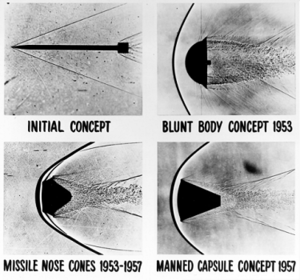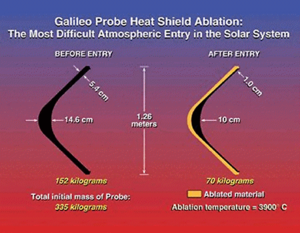Atmospheric reentry
|
|
Atmospheric entry is the transition from the vacuum of space to the atmosphere of any planet or other celestial body. The term is not used for landing on bodies which have no atmosphere e.g. the Moon.
Atmospheric reentry refers to the return to an atmosphere previously left for space. Often the word "atmospheric" is dropped and the term reentry (or re-entry) is taken to mean atmospheric reentry in context.
| Contents |
Advantage of atmosphere
Compared with landing on a planet without atmosphere, atmospheric entry has the advantage that no rocket is needed for deceleration. This gives a considerable reduction of the total delta-v needed for a spaceflight from the Earth, with return with soft landing, such as in the case of a manned spaceflight. Without this saving such a spaceflight would cost a delta-v of twice the 9.7 km/s for launch, is 19.4 km/s, which may even be impossible with current technology.
From a Low Earth Orbit a deorbit burn is needed, but this costs a delta-v of only ca. 80 m/s, depending on the altitude. From elsewhere a transfer orbit can be chosen that directly enters the atmosphere.
Objectives
For a manned spacecraft and for objects of value the requirements are:
- decelerations in the atmosphere are gentle enough
- the landing is soft
- not too much heat is developed.
- the landing does not cause damage on the surface and is in international waters or in a suitable country, with recovery vehicles ready.
For expendable objects, preventing damage at Earth's surface is the objective. This is accomplished by either burning up or evaporating the object in the atmosphere, or by bringing it down on deserted land or water. For example, even if the Hubble Space Telescope would no longer be needed, it would still be necessary to carry out a mission to attach a de-orbit rocket, for either controlled reentry or moving it to a higher orbit.
Suborbital flights
Because a major difference between sub-orbital and orbital spaceflights is the greater speed of the latter, atmospheric reentry poses much more of a technical challenge with orbital flights than with suborbital flights. This article will focus on orbital reentry, though the same considerations apply with sub-orbital flights, only to a lesser extent. Also note that the below only really applies to flights where the vehicle needs to return to Earth intact. If the vehicle is, say, a satellite that is ultimately expendable, then there naturally is no need to worry about deceleration and non-destructive reentry.
Deceleration and aerobraking
The main challenge with reentry is deceleration from high orbital speeds. To avoid our orbital spacecraft performing a meteor-style "landing", it has to slow down. An obvious way of slowing down is through atmospheric friction and drag (ie. using wind resistance) . This is called aerobraking. When an object moves through the atmosphere faster than the speed of sound, it also generates shockwaves in front of it as it "collides" with particles and compresses them faster than they can be moved out of its path. Orbital velocity for most space craft can be many times the speed of sound, and at such a high velocity, air molecules in the path of the space craft are shock heated, or compressed so violently that the temperature of the shockwave increases to thousands of degrees. Meteorites entering the Earth's atmosphere are often vaporized or crushed by their own shockwaves. So is there a better way?
Considerations when designing an Atmospheric Entry Vehicle
There are four critical parameters considered when designing a vehicle for atmospheric entry:
- Peak heat flux
- Heat load (integrated heat flux)
- Peak deceleration
- Peak dynamic pressure
Peak heat flux selects the Thermal Protection System (TPS) material. Heat load selects the thickness of the TPS material stack. Peak deceleration is of major importance for manned missions. The upper limit for manned return to Earth from Low Earth Orbit (LEO) or lunar return is 10 G. For martian atmospheric entry after long exposure to zero gravity, the upper limit is 4 G. Peak dynamic pressure can also select the outer most TPS material if spallation is an issue.
The designer typically considers two worst case trajectories, i.e. the undershoot and overshoot trajectories. The overshoot trajectory is typically defined as the shallowest allowable velocity entry angle prior to atmospheric skip-off. The overshoot trajectory has the highest heat load and sets the TPS thickness. The undershoot trajectory is defined by the steepest allowable trajectory. For manned missions the steepest entry angle is limited by the peak deceleration. The undershoot trajectory has the highest heat flux and therefore sets the TPS material.
The key to successful reentry
The key challenge with successful reentry then is to brake as much as possible while still in higher atmospheric layers and avoid plunging downwards too quickly. The higher atmospheric layers are thin enough that a space craft can bleed off much of its kinetic energy for heat while producing relatively mild shockwaves and less intense shock heating.
Why active braking cannot be solely relied upon
Of course, some active braking is required in order to enter the atmosphere, until then no atmospheric drag is available. In theory, it would be imaginable to accomplish all or practically all the deceleration by active, powered braking, by firing the craft's rocket engine in the opposite direction. This however would require a large amount of fuel, this fuel would have had to be lifted into orbit in the first place and therefore the size of the orbiting space craft relative to the launch vehicle would have to be much smaller, unless the spacecraft were refuelled in orbit. Thus, the only currently known and feasible way of decelerating from orbital speeds is mainly through aerobraking.
Reliance on heat shields
Conventional wisdom dictates that aerobraking is best achieved through orienting the returning space craft to fly at a high drag attitude coupled with ultra strong heat shields on the spacecraft, to convert the craft's high kinetic energy into thermal energy (heat) by shock heating. This unavoidably rapid conversion of a large amount of kinetic energy to heat results in extremely high temperatures, so the heat shield needs to be able to withstand such high temperatures at least long enough to protect the less durable reentry vehicle. Relying mainly on the heat shield (and possibly a high drag attitude) makes reentry a critical time. Any errors in this portion of the flight profile are difficult to recover from and will probably have serious impact upon the mission. Death and/or mission failures have occurred during re-entry. Nevertheless, the use of strong heat shields has so far been regarded as the only practical approach and all orbital returning spacecraft have been equipped with such.
Blunt body heat shields
These four shadowgraph images represent early re-entry vehicle concepts. A shadowgraph is a process that makes visible the disturbances that occur in a fluid flow at high velocity, in which light passing through a flowing fluid is refracted by the density gradients in the fluid resulting in bright and dark areas on a screen placed behind the fluid.H. Julian Allen pioneered and developed the Blunt Body Theory which made possible the heat shield designs that were embodied in the Mercury, Gemini and Apollo space capsules, enabling astronauts to survive the fiery re-entry into Earth's atmosphere. A blunt body produces a shockwave in front of the vehicle--visible in the photo--that actually shields the reentry vehicle from excessive heating, with most of the intense heat being absorbed by the heat shield itself. As a result, blunt body vehicles can stay cooler than pointy, low drag vehicles.
Interestingly, the shockwave itself can also provide extra braking for a reentry space craft, reducing the reliance on atmospheric drag from friction. The Space Shuttle's heat resistance tiles, for example, are relatively brittle and break very easily. Lining the botton of the shuttle, these tiles can be exposed to temperatures of tens of thousands of degrees on one side, but warm to the touch on the other side, unlike traditional ablaitive heat shields that vaporize when heated to direct energy away from the reentry vehicle itself.
A lot of heat is radiated. Tilting the body leads to lift prolonging the reentry, the space shuttle is the extreme case of this.
Feathered reentry
However, maverick aircraft designer Burt Rutan has recently (as of 2004) demonstrated the feasibility of an alternative or complementary approach to atmospheric reentry with the suborbital SpaceShipOne:
SpaceShipOne has what has been described as a pair of flipping wings; the spacecraft itself changes shape for reentry.
This increases drag, as the craft is now less streamlined. This results in more atmospheric gas particles hitting the spacecraft at higher altitudes than otherwise. The aircraft thus slows down more in higher atmospheric layers (which is the very key to efficient reentry, see above). It should also be noted that SpaceShipOne, in its "wings flipped" configuration, will automatically orient itself to a high drag attitude. Rutan has compared this to a falling shuttlecock.
However, it is important to realise that the velocity obtained by SpaceShipOne prior to reentry is much lower than of an orbital spacecraft, and most engineers (including Rutan) do not consider the shuttlecock reentry technique viable for return from orbit.
Related info
The highest speed reentry so far was achieved by the Jupiter atmosphere probe aboard the Galileo spacecraft, which reached 170,700 km per hour and a temperature of 14,000 °C.
Notable reentry mishaps occurred during the following missions:
- Vostok 1 - service module failed to detach for 10 minutes, but the crew survived
- Voskhod 2 - service module failed to detach for some time, but the crew survived
- Soyuz 5 - service module failed to detach, but crew survived
- Soyuz 11 - crew perished due to early depressurization
- Space Shuttle Columbia disaster - damaged heat shield led to spacecraft breakup at high altitude, crew perished
- Genesis - parachute failed to deploy, unmanned capsule crashed into desert floor, contents damaged but some science data recoverable
Uncontrolled reentry
More than 100 metric tons of man-made objects reenter in an uncontrolled fashion each year. The vast majority burn up before reaching earth's surface. On average, about one cataloged object reenters per day. Approximately, one-fourth of all objects are of U.S. origin. Due to the Earth's surface being primarily water, most objects that survive re-entry land in one of the world's oceans.


